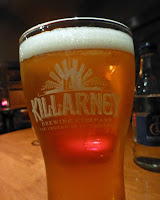With Cork Cheese Week on (big weekend coming up at Cork Airport Hotel), thought you might like to read this 2016 post on Cheese and Beer, featuring Garrett Oliver, the renowned brewmaster at the Brooklyn Brewery.
Brewmaster on Real Beer and Real Food
Garrett Oliver in Oxford Companion to Cheese
 |
| Garrett Oliver |
Garrett Oliver started a Ballymaloe LitFest talk and beer tasting, with this line. Soon, he would delve into bread and cheese, including fake bread and fake cheese.
Garrett played a key role as the brewing/culinary pairing concept reached a critical turning point in 2003, according to the newly published Beer FAQ by Jeff Cioletti. That was the year that Garrett's book, The Brewmaster's Table: Discovering the Pleasures of Real Beer with Real Food, saw its first publication. He was also the editor of the Oxford Companion to Beer.
So it no surprise to see the dapper brewmaster at the Brooklyn Brewery listed as one of the 325 contributors to the just published Oxford Companion on Cheese.
But Oliver, tasked with pairing beer with cheese, is in his comfort zone. And, as in Ballymaloe, he first refers to the 20th century industrialisation of food and beverages “into nearly unrecognisable facsimiles of themselves” before craft began to restore “variety, subletly and life”.
And so, in speaking of pairing, Garrett is talking craft and artisan. And he outlines the reasons why beer and cheese go so well together and, as always, he doesn't fail to boot wine down the list as a contender! In Ballymaloe, he said champagne comes in a beer bottle, not the other way round!
In quite a hefty contribution, he goes through all the types of beer, from light ales to Imperial Stouts. You’ll have to get the book to see all the possibilities but let's have a look in the middle of the list under the heading Wheat Beers and Saisons.
“Wheat beers..are slightly acidic, fruity, spritzy, and refreshing as well as low in bitterness. In contrast, the Belgian farmhouse saison style tends to add sharper bitterness, often alongside peppery notes. These beers make great matches for tangy fresh goats cheeses, and can be a great way to start off a cheese and beer tasting.”
 |
| Brewer's Gold from Ireland's Little Milk Co. |
This book is huge and is very inclusive indeed with no less than 855 entries and claims to be the most comprehensive reference work on cheese available. It is well written, well edited and both the expert and professional will find something of value. But it is not the type of book I’d read from start to finish.
It is one to dip into and that is what I’m doing here, just to give you a flavour. So if you want to look up kashkaval, you’ll find it is a hard cheese from the Balkans. Preveli is a semi-hard Croatian cheese.
 |
| Coolea |
And it is not just technical. There are many practical entries. Perhaps one that we could all read is under Home Cheese Care. Here you’ll read that the fridge may be bad for your cheese as it can be too cold for some aged styles.
And there are quite a few entries on the history of cheese around the world, including the Americas. Indeed, the book is published in the US. Was it Irish monks that first brought cheesemaking skills to St Gallen in Switzerland? Nowadays, in a possible reverse, you can get a lovely St Gall from the Fermoy Natural Cheese Company.
And how come it is only over the past forty years or so that Irish cheese is on the rise, Irish artisan cheese that is. In the Ireland entry, you read that by the 17th century, many distinctive aspects of Irish life and culture, including the Gaelic Farm economy and the native cheesemaking tradition, had been killed off by decades of oppressive English law. It took us an overly long time to recover!
Cashel Blue, as far as I can see, is the one Irish cheese to get an entry to itself. Cheeses, most of them famous, from all over the world are highlighted, including from places such as Turkey and Iran.
Hundreds of cheeses then but here are just a few of the better known ones that you may read about: Camembert, Chabichou, Cheshire, Gorgonzola, Gouda, Gruyere, Jack, Livarot, Mont d’Or, Ossau-iraty, Parmigiana Reggiani, Pecorino, Raclette, Reblochon, Stilton, Tomme, and Wensleydale.
And, by the way, Garret Oliver didn't get the matching field to himself! There is also an entry on wine pairing by Tara Q. Thomas!
The Oxford Companion to Cheese (December 2016), is edited by Catherine Donnelly, published by the Oxford University Press. Price: £40.00.
* The book also lists cheese museums around the world. None in Ireland, yet!
See also:


































